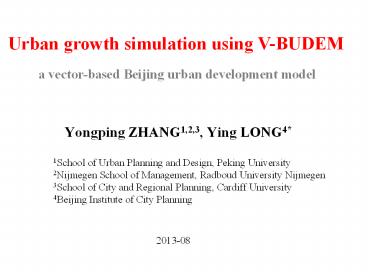Urban growth simulation using V-BUDEM - PowerPoint PPT Presentation
Title:
Urban growth simulation using V-BUDEM
Description:
Urban growth simulation using V-BUDEM. 1School of Urban Planning and Design, Peking University. 2Nijmegen School of Management, Radboud University Nijmegen – PowerPoint PPT presentation
Number of Views:216
Avg rating:3.0/5.0
Title: Urban growth simulation using V-BUDEM
1
Urban growth simulation using V-BUDEM
a vector-based Beijing urban development model
Yongping ZHANG1,2,3, Ying LONG4
1School of Urban Planning and Design, Peking
University 2Nijmegen School of Management,
Radboud University Nijmegen 3School of City and
Regional Planning, Cardiff University 4Beijing
Institute of City Planning
2013-08
2
Outline
- 1. Introduction
- 2. V-BUDEM
- 3. Model application
- 4. Conclusion and discussion
3
1. INTRODUCTION
4
Vector CA
- Raster CA extensively applied for simulating
urban growth - Batty, Clarke, Engelen, Li, White, Wu, Xie, Yeh
- Simulation results of raster CA sensitive to grid
resolution and neighborhood configuration - Jenerette and Wu (2001), Chen and Mynett (2003),
Jantz and Goetz (2005), Ménard and Marceau (2005) - Vector , or irregular CA, more representative to
the real world - Geographical entities (e.g. parcels, with Shi and
Pang 2000 as an exception using Voronoi polygon)
replace grids
5
BUDEM
- Long et al, 2009 (Tsinghua Science and
Technology) - Beijing Urban Development Model
- Raster CA
- Supporting city planning and corresponding
policies evaluation - Urban built-up non urban built-up
6
This paper is regarded with
- Improve initial raster BUDEM into vector V-BUDEM
- Focused on the urban growth simulation at this
stage - Test it in a small town of Beijing
7
2. V-BUDEM
8
Spatial factor selection
- Spatial variables in V-BUDEM
- Same with those in BUDEM
Type of variables Name Value Description
Self-status Isrural 0, 1 Whether the cell is rural built-up land in the previous iteration
Self-status Isagri 0, 1 Whether the cell is agricultural land in the previous iteration
Location d_tam 0 Minimum distance to Tiananmen Square
Location d_vcity 0 Minimum distance to important new city
Location d_city 0 Minimum distance to new city
Location d_vtown 0 Minimum distance to important town
Location d_town 0 Minimum distance to town
Location d_river 0 Minimum distance to river
Location d_road 0 Minimum distance to road
Location d_bdtown 0 Minimum distance to town boundaries
Government Planning 0, 1 Whether planned as urban built-up
Government con_f 0, 1 Whether in the forbidden zone
Government Landresource 1-8 Land suitability classified for agriculture
Neighbor Neighbour 0-1.0 Neighborhood development intensity
9
Conceptual model
- The Beijing metropolitan area (BMA)
- The parcel the cell
- The neighbourhood
- all parcels surrounding the cell within a certain
distance - CA states
- 1 for urban built-up land
- 0 for other land
- The transition rule
- Multi-criteria evaluation (MCE)
10
Parcel subdivision
- Parcel subdivision is common in reality
- Alexandridis and Pijanowski (2007) Vanegas et
al. (2008) Wickramasuriya et al. (2011, 2013) - Introduce a semi-automated method
- Intersect current and planned land use pattern,
keeping all attributes - Summarize the total area, according to Plan_ID
and land type (e.g. urban built-up and other
land) - Summarize the total area, according to Plan_ID
- Join tables created by step 2 and 3, according to
Plan_ID. Each Plan_ID corresponds to a land type,
which owns the maximum area ratio. - Join the result of step 4 with planned land use
pattern, and we get the subdivided current land
use pattern.
11
Simulation process
12
Simulation process
13
The transition rule
development suitability
final transition probability
random item
14
3. MODEL APPLICATION
15
Study area
The Beijing metropolitan area
The current land use pattern of Xiji Town in 2010
16
After parcel subdivision
The changed current land use pattern
The planned land use pattern
17
XIJI2020 simulation
- From 2010 to 2020
- Policy parameter set for 2006-2020
- The whole BMA
Name Coefficient Name Coefficient
isrural 6.886 21 d_river -0.000 52
Isagri 6.971 87 d_road -0.000 96
d_tam -0.000 10 d_bdtown -0.000 27
d_vcity -0.000 03 planning 8.770 71
d_city -0.000 10 con_f -0.200 97
d_vtown -0.000 28 landresource -0.093 55
d_town -0.000 11 neighbor 4.598 08
p (significance) 0.001 p 0.05 p 0.5
18
V-BUDEM result
- Neighborhood distance 60 m
- Tested 10-100 m
- Time step
- 5 times with a total of 10 years
- Kappa 86.52
- Developed area
- 6.95 km2
- smaller than predicted 8.77 km2
- Large parcels
Simulation result in 2020 using V-BUDEM
19
BUDEM result
- 3030 m grid
- Kappa 79.51
Simulation result in 2020 using BUDEM
20
Result comparison
- Using the parameter set to Xiji in V-BUDEM was
comparatively more suitable than that in BUDEM - In V-BUDEM
- The parcel would be developed or undeveloped as a
whole unit - In BUDEM
- Part areas of some parcels would be transited
into urban built-up land, while other part areas
would keep other land type - Unlikely to be happened in reality
- Parcel space was a little different with the
space consisted by grid - For cell boundary could be out of parcel
boundary, and it could cause some inaccuracies as
a result.
21
5. CONCLUSION AND DISCUSSION
22
Conclusion
- V-BUDEM was proposed, and a preliminary test was
conducted - more close to the real situation
- aiming to the application of urban planning
- comprehensive constraints
- basic farmland protection and forbidden built-up
areas - The semi-automated parcel subdivision method
- a new solution
- determine the basic simulation spatial units for
V-BUDEM - easy to implement and speed-up the model run
23
Future work
- Expand to the whole BMA
- Integrated automated parcel subdivision tool
- Wickramasuriya et al. (2011)
- Established the land use pattern in detail
- Residential, commercial, and industrial land
types - Planner Agent (Zhang and Long, 2013)
24
Thanks!
- longying1980_at_gmail.com

